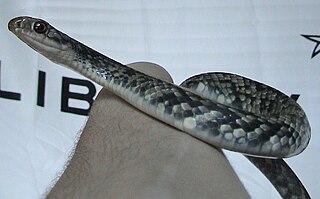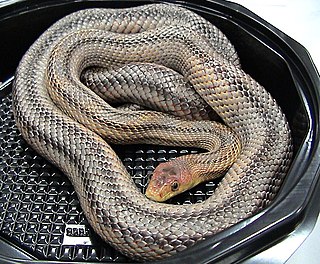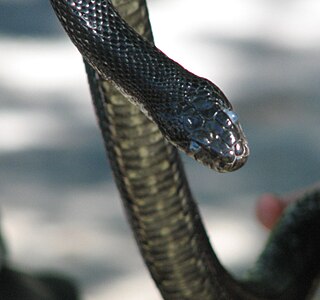
Pantherophis obsoletus, also known commonly as the western rat snake, black rat snake, pilot black snake, or simply black snake, is a nonvenomous species of snake in the family Colubridae. The species is native to central North America. There are no subspecies that are recognized as being valid. Its color variations include the Texas rat snake. Along with other snakes of the eastern United States, like the eastern indigo snake and the eastern racer, it is called “black snake”.

Masticophis flagellum is a species of nonvenomous colubrid snake, commonly referred to as the coachwhip or the whip snake, which is endemic to the United States and Mexico. Six subspecies are recognized, including the nominotypical subspecies.

Tropidoclonion is a genus of snake in the subfamily Natricinae of the family Colubridae. The genus is monotypic, containing the sole species Tropidoclonion lineatum, commonly known as the lined snake. The species is endemic to North America.

Coluber constrictor anthicus, commonly known as the buttermilk racer, is a subspecies of the eastern racer, a nonvenomous colubrid snake, endemic to the southern United States.

Cemophora coccinea, commonly known as the scarlet snake, is a species of nonvenomous snake in the family Colubridae. The species is native to the southeastern United States. There are two subspecies of C. coccinea that are recognized as being valid. The Texas scarlet snake was previously considered a subspecies.

The eastern racer, or North American racer, is a species of nonvenomous snake in the family Colubridae. The species is endemic to North America and Central America. Eleven subspecies, including the nominotypical subspecies, are recognized, which as a group are commonly referred to as the eastern racers. The species is monotypic in the genus Coluber.

The southern black racer is one of the more common subspecies of the nonvenomous Coluber constrictor snake species of the Southeastern United States. The subspecific name priapus refers to the proximal spines of the hemipenes being much enlarged into basal hooks, which is characteristic of this subspecies. These snakes are quite active during the day, which increases the chance of sightings. They eat almost any animal they can overpower, including rodents, frogs, toads, and lizards. Members of this species generally do not tolerate handling – even after months in captivity – and typically strike and flail wildly every time they are handled, often defecating a foul-smelling musk, a common defense against predators in snakes. Adults of the species are usually thin with a jet-black dorsal side with a grey belly and white chin. They are quite fast, giving them the name "racer".

Coluber constrictor oaxaca, commonly known as the Mexican racer, is a nonvenomous colubrid snake, a subspecies of the eastern racer.
Coluber constrictor etheridgei, commonly known as the tan racer, is a subspecies of nonvenomous snake in the family Colubridae, a subspecies of the eastern racer. The subspecies is native to the southern United States.

The Texas rat snake is a subspecies of the black rat snake, a nonvenomous colubrid. It is found in the United States, primarily within the state of Texas, but its range extends into Louisiana, Arkansas and Oklahoma. It intergrades with other subspecies of Elaphe obsoleta, so exact range boundaries are impossible to distinguish. The epithet lindheimeri is to honor the German-American naturalist Ferdinand Jacob Lindheimer, who collected the first specimen in New Braunfels, Texas.

Pantherophis emoryi, commonly known as the Great Plains rat snake, is a species of nonvenomous rat snake in the family Colubridae. The species is native to the central part of the United States, from Missouri to Nebraska, to Colorado, south to Texas, and into northern Mexico.

Pantherophis bairdi is a species of harmless snake in the family Colubridae. The species is native to the southwestern United States and adjacent northeastern Mexico. No subspecies are recognized as being valid.

The banded water snake or southern water snake is a species of mostly aquatic, nonvenomous, colubrid snakes most commonly found in the Midwest, Southeastern United States and Caribbean.

Coluber constrictor foxii, commonly known as the blue racer, is a subspecies of Coluber constrictor, a species of nonvenomous, colubrid snake commonly referred to as the eastern racer.

The bullsnake is a large, nonvenomous, colubrid snake. It is a subspecies of the gopher snake. The bullsnake is one of the largest/longest snakes of North America and the United States, reaching lengths up to 8 ft.
Wyoming is home to 12 amphibian species and 22 species of reptiles.

Pantherophis alleghaniensis, commonly called the eastern rat snake, is a species of nonvenomous snake in the family Colubridae. The species is endemic to North America.

The western yellow-bellied racer, also known as the western yellowbelly racer or western racer, is a snake subspecies endemic to the Western United States, including California, Oregon, Idaho, Nevada, New Mexico, Utah, Montana and Colorado. It is a subspecies of the eastern racer. It is nonvenomous and is recognized by its long and very slender shape. It is visually similar to the eastern yellow-bellied racer, which is also green, blue or brown with a recognizable yellow underside. Also named for its color, the western yellow-bellied racer is also gray with red or brown blotches when young.

The northern black racer is a subspecies of the eastern racer, a nonvenomous snake in the family Colubridae. Their geographic range extends from southern Maine to northern Georgia and westward to central Kentucky and eastern Ohio. Their occupancy is dependent on the availability of large patches of open habitats.

















